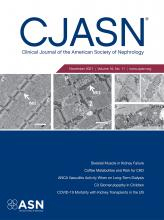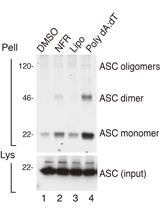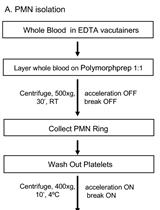- EN - English
- CN - 中文
Serological Measurement of Poly-IgA Immune Complex Levels in IgA Nephropathy and IgA Vasculitis
IgA 肾病和 IgA 血管炎中多聚 IgA 免疫复合物水平的血清学测定
发布: 2022年07月05日第12卷第13期 DOI: 10.21769/BioProtoc.4463 浏览次数: 3238
评审: Xiaoyi ZhengAnonymous reviewer(s)
Abstract
Both IgA nephropathy and IgA vasculitis, formerly known as Henoch-Schӧnlein purpura, are immune deposition diseases. IgA nephropathy is caused by the deposition of aberrantly formed poly-IgA complexes from blood circulation to the kidney glomerulus; IgA vasculitis is characterized by IgA-dominant immune deposits to small vessels of the skin and other organs, including the kidney. Therefore, measuring the disease-causing poly-IgA contents in the plasma is needed to study these conditions. However, while clinical tests for the level of total plasma IgA are routinely performed, methods for specific detection of poly-IgA contents are unavailable in clinical medicine. In this protocol, we describe a practical solution for measuring poly-IgA in patient samples. The new method is based on the biological selectivity of IgA Fcα receptor I (FcαRI/CD89) toward poly-IgA species, in contrast to its relatively low affinity for normal monomeric IgA. By devising recombinant CD89 ectodomain as the “capturing” probe, we validated the feasibility of the assay for measuring plasma poly-IgA levels in a 96-well format. The methodology was able to differentiate plasma samples of IgA nephropathy, or related IgA vasculitis, from those of other autoimmune kidney disease types or from healthy controls. Moreover, the measured poly-IgA indices not only correlated with the severity of IgA nephropathy, but the levels also trended lower following corticosteroid or immunosuppressant treatments of patients. Therefore, we anticipate the new assay will provide useful measurements of the IgA nephropathy disease activity index for stratifying disease severity or for evaluating treatment response.
Graphical abstract:
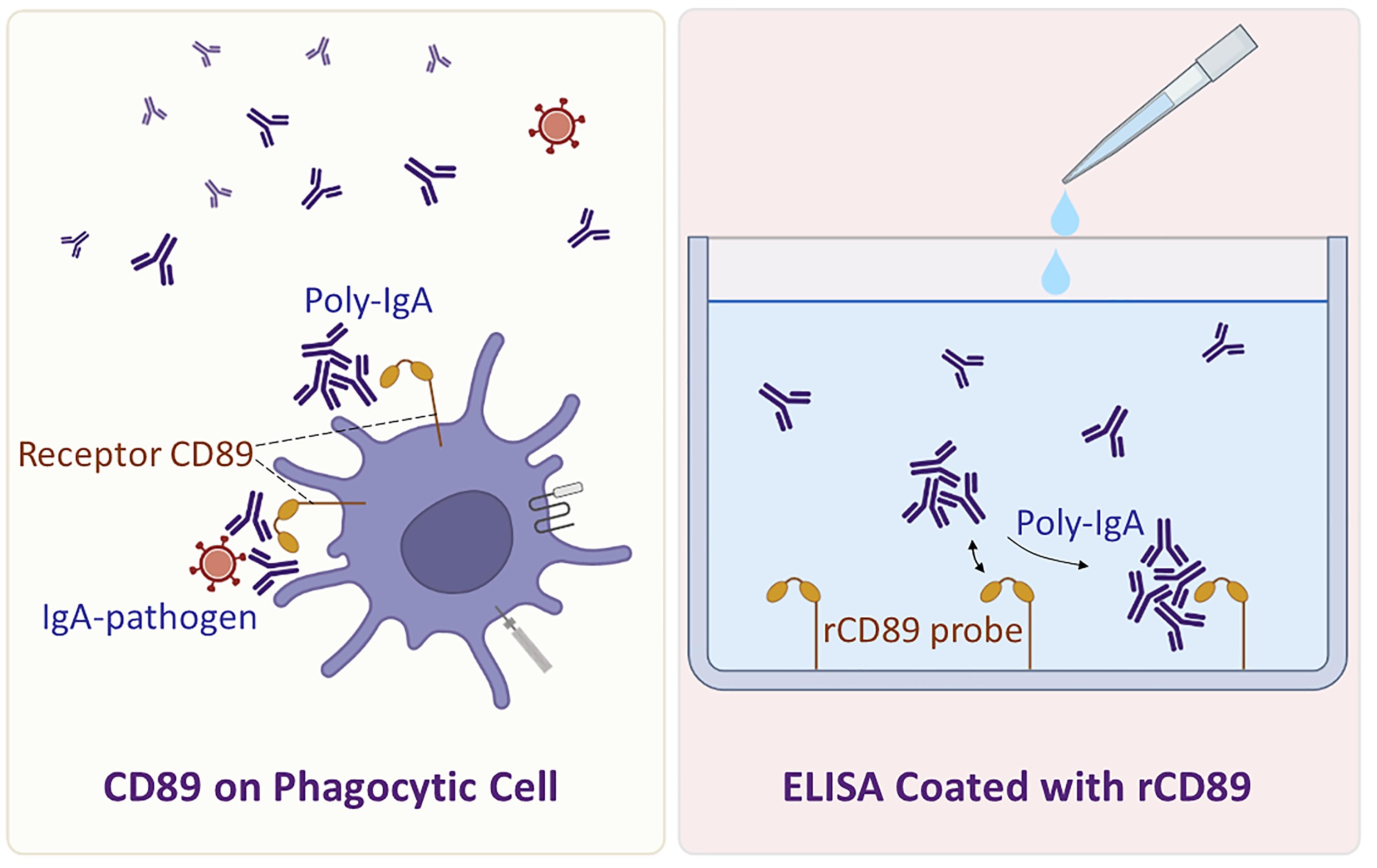
Background
IgA nephropathy is the most common form of primary glomerulonephritis worldwide (Lai et al., 2016). The diagnosis requires renal biopsy and there are no validated diagnostic serum or urine biomarkers for IgA nephropathy. Among recognized risk factors, high levels of galactose-deficient IgA1 (Gd-IgA1) and excessive formation of poly-IgA immune complexes in circulation are associated with kidney glomerular deposition (Magistroni et al., 2015). The observations of recurrent IgA deposition in kidney grafts in transplant recipients with IgA nephropathy strongly suggest the extrarenal origin of IgA as the source of the renal deposits (Moroni et al., 2019). This notion is further supported by evidence of circulating immune complexes in patients sharing the same immunoglobulin classes with IgA extracted from the kidney (Kanatsu et al., 1983). Local immune reactivities to the IgA deposits in the glomerulus stimulate proliferation of mesangial cells, synthesis of extracellular matrix, and infiltration of inflammatory cells (Magistroni et al., 2015).
Meanwhile, circulating IgA immune complexes are catabolized primarily by the mononuclear phagocyte system via IgA Fcα receptor I (FcαRI/CD89) (Chen et al., 2018). CD89 is a type I transmembrane glycoprotein broadly expressed on the surface of myeloid cells, including monocytes/macrophages, dendritic cells, Kupffer cells, neutrophils, and eosinophils (Maliszewski et al., 1990; Monteiro and Van De Winkel, 2003; Bakema and van Egmond, 2011). This IgA-specific receptor binds both IgA1 and IgA2 through its N-terminus Ig domain, which interacts with the Cα2/Cα3 junction of IgA (Herr et al., 2003). Previously, we and others demonstrated that CD89 exhibits higher affinities to polymeric IgA than to monomeric IgA, allowing phagocytes to selectively capture poly-IgA complexes (Reterink et al., 1997; Zhang et al., 2021).
To this end, we constructed a recombinant (r) CD89-based affinity probe for serological detection of poly-IgA immune complexes in clinical samples, namely from patients with IgA nephropathy and IgA vasculitis, formerly known as Henoch-Schӧnlein purpura (HSP) (Zhang et al., 2020). In our study, we demonstrated that rCD89 can distinctively capture poly-IgA in the plasma samples, making this rCD89 probe suitable for measuring only the disease-causing poly-IgA contents without the interference of background signals from normal IgA species. The probe was mounted on ELISA plates and the tests were performed directly with diluted plasma samples. Using this high-throughput test, we demonstrated significantly elevated levels of poly-IgA complexes in IgA nephropathy and HSP samples, as compared to either healthy controls or samples from other kidney disease types (Figure 1). The results outperformed those obtained from measurements of either total IgA or Gd-IgA1 levels regarding disease correlation. It is important to note that despite the recognition of circulating poly-IgA complexes being prone to deposition in the kidney and elsewhere, clinical tests for their levels are unavailable. Research labs have been using size-exclusion chromatography (SEC) to isolate and characterize high-molecular weight IgA complexes. However, the procedures are cumbersome and the quality of poly-IgA separation from their monomeric and dimeric counterparts by SEC is poor (Reterink et al., 1997; Novak et al., 2005, 2011). In addition, chromatography requires pre-extraction of IgA and these additional steps have the tendency to introduce experimental artifacts of IgA self-aggregation (Hui et al., 2015). In contrast, our recombinant CD89-directed ELISA is a robust assay that can be easily automated and further adapted to clinical applications. Here we describe the experimental workflow in a research lab setting.
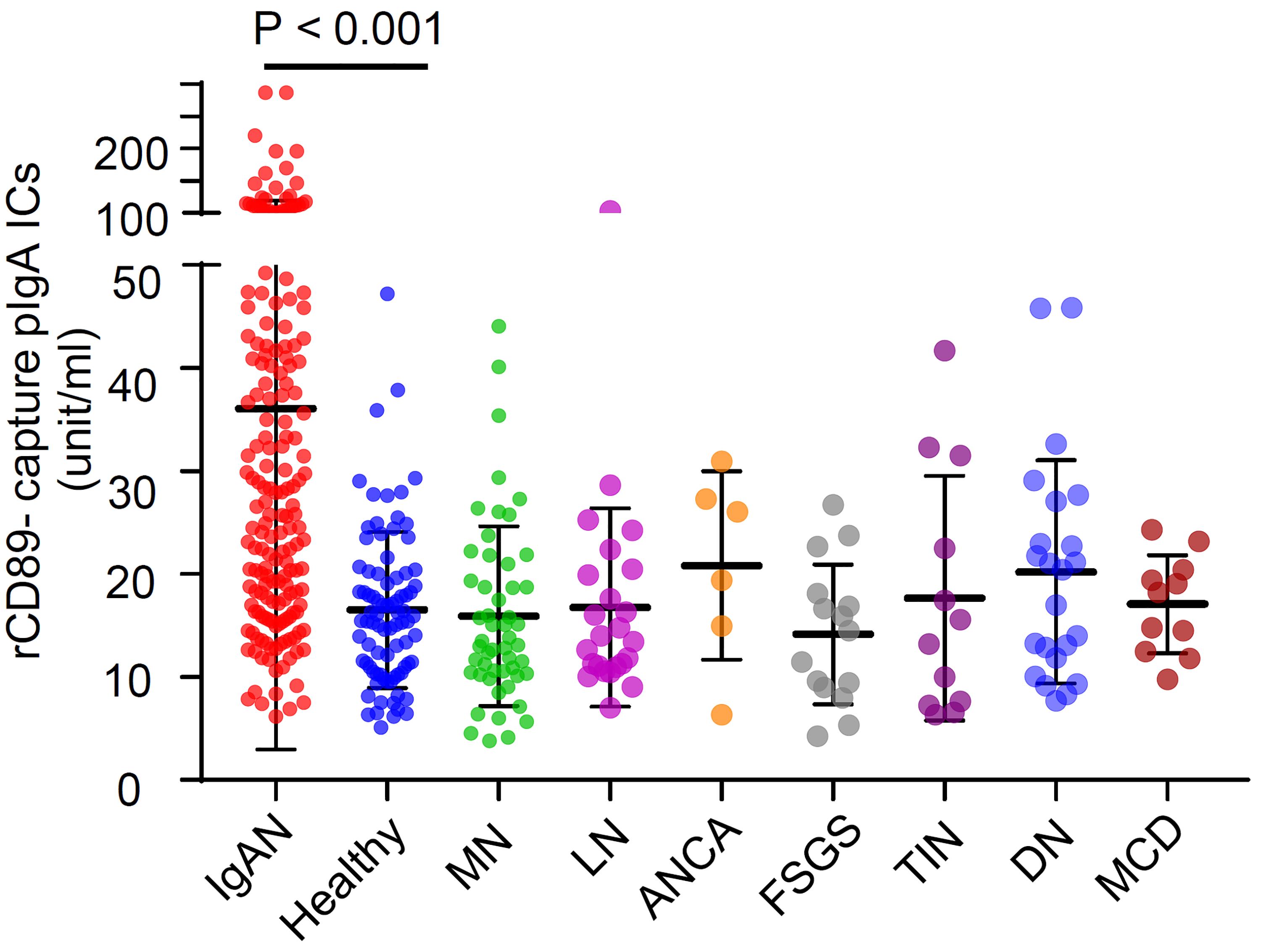
Figure 1. Comparison of plasma poly-IgA levels among different kidney diseases. The rCD89-directed ELISA kit detects higher poly-IgA levels in plasma samples of IgAN patients, as compared to samples of healthy controls or non-IgAN kidney disease types, including membranous nephropathy (MN), lupus nephritis (LN), ANCA nephritis, Focal Segmental glomerulosclerosis (FSGS), tubulointerstitial nephritis (TIN), diabetic nephropathy (DN), and minimum change disease (MCD). (Note that the figure was adapted from Zhang et al., 2021)
Materials and Reagents
Disposable tips
10 μL capacity (Thermo Fisher Scientific, QSP, catalog number: 104-Q, Rockford, US)
200 μL capacity (Thermo Fisher Scientific, QSP, catalog number: TF140-200-Q, Rockford, US)
1 mL capacity (Thermo Fisher Scientific, QSP, catalog number: 112NXL-Q, Rockford, US)
1.5 mL Microcentrifuge tube (Thermo Fisher Scientific, Invitrogen, catalog number: AM12400, Carlsbad, US)
100 mm culture dish (Corning, Falcon, catalog number: 353003, Glendale, US)
Amicon Ultra-15 centrifugal filter units, 10 kDa MWCO (Sigma, Millipore, catalog number: UFC901024, Darmstadt, Germany)
Carbonate bi-carbonate coating buffer (Medicago, catalog number: 09-8922-100, Uppsala, Sweden)
Bovine serum albumin (Sigma, catalog number: 90604-29-8, Saint Louis, US)
Tween-20 (Thermo Fisher Scientific, catalog number: BP337500, Carlsbad, US)
pcDNA3 expression vector (Thermo Fisher Scientific, Invitrogen™, catalog number: V79020, Carlsbad, US)
HEK293 cells (ATCC, catalog number: CRL-1573, Manassas, US)
Lipofectamine 2000 transfection reagent (Thermo Fisher Scientific, Invitrogen, catalog number: 11668027, Carlsbad, US)
Geneticin/G418 (Thermo Fisher Scientific, Gibco, catalog number: 11811023, Carlsbad, US)
Dulbecco’s Modified Eagle’s Medium (Life Sciences, Corning, catalog number: 10-017-CV, Glendale, US)
Fetal bovine serum (Thermo Fisher Scientific, Gibco, catalog number: 10099141, Carlsbad, US)
Commercial CD89 protein, human, recombinant (Sino Biological, catalog number: 10414-H08H, Beijing, China)
Human IgA1 standard, myeloma (Sigma, catalog number: 400109, Saint Louis, US)
PBS powder (Sigma, catalog number: P3813, Saint Louis, US)
3×FLAG peptide (Sigma, catalog number: F4799, Saint Louis, US)
ANTI-FLAG M2 affinity gel (Sigma, catalog number: A2220, Saint Louis, US)
Slide-A-Lyzer Dialysis Cassettes (Thermo Scientific, catalog number: 66380, Carlsbad, US)
Bio-Rad Protein Assay Dye Reagent (Bio-Rad, catalog number: #5000006, Hercules, US)
Primary antibodies and secondary antibodies
HRP-conjugated anti-DDDDK tag antibody [M2] (Abcam, catalog number: ab49763, Waltham, US)
HRP-conjugated anti-human IgA antibody [1H9] (Abcam, catalog number: ab7383, Waltham, US)
Recombinant anti-CD89 antibody (Abcam, catalog number: ab124717, Waltham, US)
ECL Western Blotting Substrate (Thermo Scientific, catalog number: 32209, Carlsbad, US)
Nunc MaxiSorp 96-Well plates (Thermo Fisher Scientific, catalog number: 44-2404-21, Glendale, US)
Immuno Clear Standard Modules (Thermo Scientific, catalog number: 468667, Carlsbad, US)
3,3′,5,5′-Tetramethylbenzidine (TMB) substrate set (BD, catalog number: 555214, Franklin Lakes, US)
Sulfuric acid (Thermo Scientific, catalog number: N600, Carlsbad, US)
Penicillin and streptomycin (Thermo Scientific, catalog number: 15140122, Carlsbad, US)
Cell culture mediums (see Recipes)
Growth medium
Selection medium
Cryopreservation medium
0.05 M carbonate sodium buffer (pH 9.6) (see Recipes)
0.01 M Phosphate Buffered Saline (PBS) buffer (see Recipes)
ELISA washing buffer (0.1% PBST buffer, pH 7.4) (see Recipes)
ELISA blocking buffer (1% BSA/PBST buffer) (see Recipes)
ELISA stop solution (1 M H2SO4) (see Recipes)
Equipment
-80°C freezer (e.g., Thermo Scientific Forma 900 Series)
Fixed volume single-channel pipettes (e.g., Thermo Fisher Scientific, catalog number: 4651140)
Refrigerated tabletop centrifuge (e.g., Thermo Sorvall Legend XTR refrigerated centrifuge)
Microplate absorbance reader (e.g.,Bio-Rad, catalog number: 1681130XTU)
CO2 incubators (e.g., Thermo Fisher Scientific, catalog number: 51032875)
Liquid nitrogen tank (e.g., Thermo Scientific)
Gel imaging system (e.g., Biorad Gel Doc XRS+ Imaging System, catalog number: 1708265)
Procedure
文章信息
版权信息
© 2022 The Authors; exclusive licensee Bio-protocol LLC.
如何引用
Zhang, X., Lv, J., Liu, P., Xie, X., Li, X., Zhang, H. and Jin, J. (2022). Serological Measurement of Poly-IgA Immune Complex Levels in IgA Nephropathy and IgA Vasculitis. Bio-protocol 12(13): e4463. DOI: 10.21769/BioProtoc.4463.
分类
免疫学 > 炎症性疾病 > 炎性小体
生物工程 > 生物医学工程
您对这篇实验方法有问题吗?
在此处发布您的问题,我们将邀请本文作者来回答。同时,我们会将您的问题发布到Bio-protocol Exchange,以便寻求社区成员的帮助。
提问指南
+ 问题描述
写下详细的问题描述,包括所有有助于他人回答您问题的信息(例如实验过程、条件和相关图像等)。
Share
Bluesky
X
Copy link


